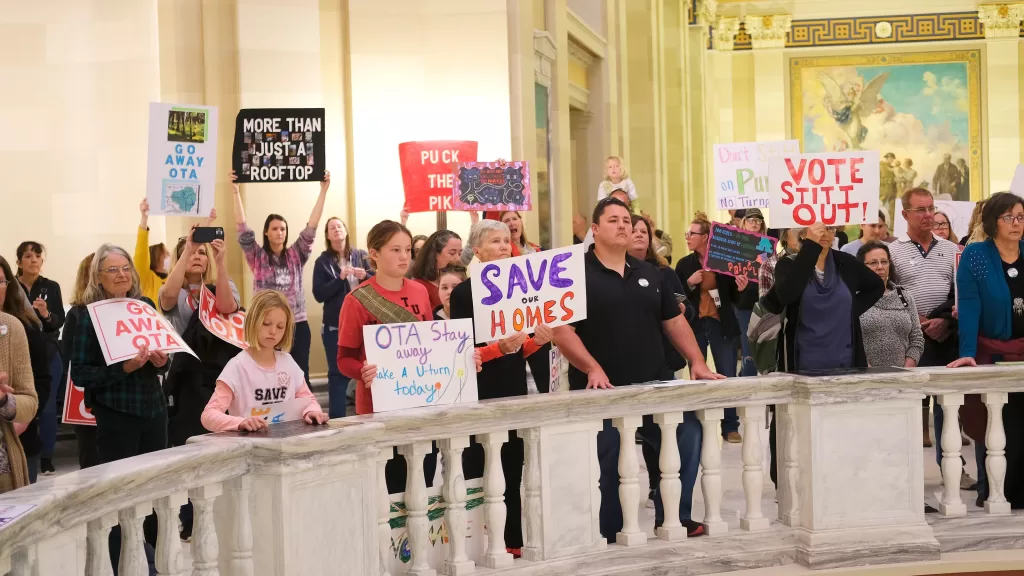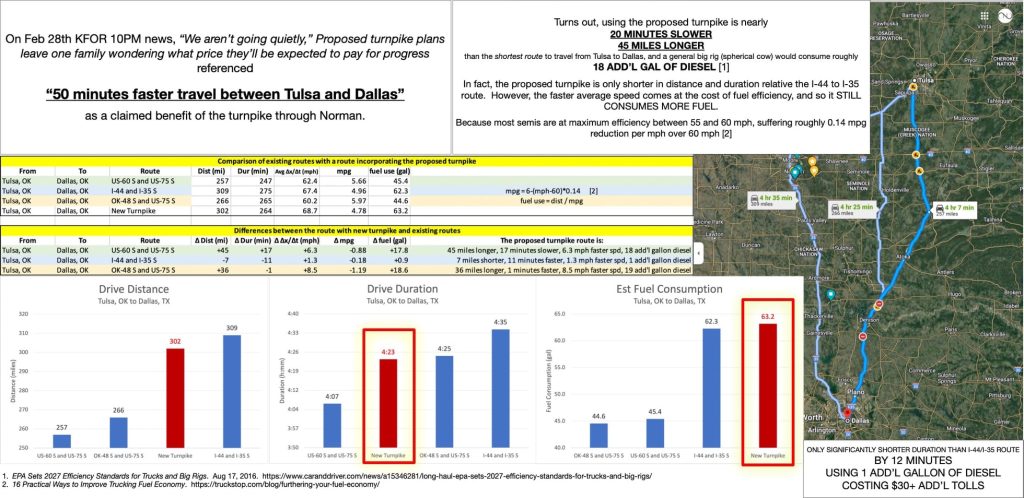
The Biggest Bully on the Block: Oklahoma Turnpike Authority
**Originally written and published by Bryan Armstrong on Ignite Liberty in March 2022. Re-printed here with permission of author.**
A Brief Background of the OTA
Imagine for a moment if the state legislature decided to create a privately funded organization in order to take over an essential function of government, and then gave that entity the power for condemnation to seize private property anytime it wants to in order to accomplish its goals.
If that were being discussed in the current legislative session there would be an outcry unlike anything this state has ever seen. Any legislator voting for it would face a wave challengers in the next election along with demands for their immediate resignation.
The scenario I just described, however, is not fiction…it’s what happened almost 70 years ago when the legislature created the Oklahoma Turnpike Authority.
A Brief History of the OTA
The OTA was created through an initiative referendum passed by the state legislature in 1954. For those of you not familiar with the different types of state questions available under the Oklahoma Constitution, here’s a brief explanation:
Initiative Petition:
A process by which the legal voters of Oklahoma have the right to propose any legislative measure or to propose amendments to the Oklahoma Constitution.
Legislative Referendum:
A method used by the Legislature to submit a proposed measure to the legal voters of Oklahoma.
Referendum Petition:
A process by which the legal voters of Oklahoma propose changes to legislation from the current legislative session, (except as to laws necessary for the immediate preservation of public peace, health or safety). Referendum petitions must be filed with the Secretary of State not more than ninety (90) days after the final adjournment of the session of the Legislature which passed the bill on which the referendum is demanded.
An example of the Initiative Petition is the recent State Questions that legalized medical marijuana.
In 1953, the state legislature passed SB 454 and HB 933 as Referendum Petitions creating the Oklahoma Turnpike Authority and authorizing the construction of two turnpikes. One became the H.E. Bailey Turnpike which connects Wichita Falls, Texas and Oklahoma City. The other was supposed to connect Oklahoma City and Wichita, Kansas along the same route as the eventual IH-35, but was never built because of the construction of the interstate.
Those two bills would then become State Questions 359 and 360, which went before a vote of the people on 26 January, 1955 in a special election. Both questions passed by identical percentage points of 56%-44%. SQ 359 passed by a margin of 40,586 votes with 174,236 voting for and 133,650 voting against. SQ 360 also passed by a 39,030 vote margin with 171,151 voting for and 132,121 voting against.
A New Kind of Entity
In the creation of the OTA, the legislature and people of Oklahoma created a new hybrid entity that was both private and public at the same time. Section 2 of State Question 360 (codified as 69 O.S. § 1703) defined the new “authority” as,
Corporate and politic to be known as the ‘Oklahoma Turnpike Authority’ and by that name the Authority may sue and be sued, and plead and be impleaded. The Authority is hereby constituted an instrumentality of the state, and the exercise by the Authority of the powers conferred by this act in the construction, operation, and maintenance of turnpike projects shall be deemed and held to be an essential governmental function of the state with all the attributes thereof.”(emphasis added)
Politically speaking, then, the OTA is imbued with the full power of the State, and with that comes the power of condemnation, otherwise known as eminent domain.
Understanding the nature of this relationship takes a rudimentary understanding of the Law of Agency. Without going through a 1L Contract Law class, the Law of Agency can be summed up as a relationship in which one person has legal authority to act for another. That includes the authority of the agent to bind the principal to financial obligations. The law of agency is based on the Latin maxim “Qui facit per alium, facit per se,” which means “he who acts through another is deemed in law to do it himself.”
Under this legal principle, the principal is legally responsible for the actions of their agent as long as they are acting under the auspices of the principal. Meaning, if the agent breaks the law, the principle could be held liable for damages as long as the principal knew what the agent was doing and the agent was acting in the full faith and credit of the principle.
Likewise, any legal restrictions on the principal would automatically apply to the agent, insomuch as those restrictions govern the actions related to their relationship. For instance, in domestic law cases when a VPO (victim’s protection order) is issued against an abuser in order to protect their victim from further abuse the VPO usually includes language that extends the legal restriction to the agents of the abuser.
One would expect that an agency of the State would have the same authority – namely to bind the State to contracts – to act on it’s authority, and to risk the State being sued should that agent act in a manner that violated any principle of civil or criminal law. Certainly if the State gives an agency the power of condemnation (one of its sternest powers), then the State should be legally liable for the actions of that agent.
However, that relationship does not exist for the OTA. 69 O.S. § 1705 (d), which gives the OTA its authority, states that, “Oklahoma Turnpike Authority is hereby authorized and empowered:
(d) To sue and be sued in contract, reverse condemnation, equity, mandamus and similar actions in its own name, plead and be impleaded; provided, that any and all actions at law or in equity against the Authority shall be brought in the county in which the principal office of the Authority shall be located, or in the county of the residence of the plaintiff, or the county where the cause of action arose. All privileges granted to the Authority and duties enjoined upon the Authority by the provisions of Sections 1701 through 1734 of this title may be enforced in a court of competent jurisdiction in an action in mandamus.”
The words at the beginning of paragraph D carry enormous legal significance. The actions that are named (to sue and be sued, plead and be impleaded, etc.) are actions that define a legal entity as being separate from another. For instance, when a child turns 18, known in the law as the “age of majority”, that child can then sue and be sued, plead and be impleaded in his or her own name as opposed to their parents. They are now legally responsible for themselves at all times.
As such, the words “in its own name” draw a sharp, clear distinction between an agent of the State – one imbued to act with full State authority, and for which the State is fully responsible – and a private entity. An agent or agency of the State, like the Oklahoma Department of Transportation, has full state authority but also binds to the State to any and all contracts it signs. The State is also responsible for overseeing and funding that agency.
By including the words “in its own name” in the definition of powers listed in 69 O.S. § 1705, the State has not created an agency. It has defined a legally separate entity for which the State cannot be held legally liable, and which does not have the authority to bind the State to contracts.
However, the State then gave this “private” entity the same legal authority the State has, namely the power to seize property by force using eminent domain in order to build turnpikes. Remember the words we italicized in 69 O.S. § 1703 above? “The Authority is hereby constituted an instrumentality of the state…projects shall be deemed and held to be an essential governmental function of the state with all the attributes thereof.” Sure seems like a full “state agency” doesn’t it?
Yet in Section 1 of SQ 360 (codified as 69 O.S. § 1702) the State tries to distance itself from the “agency” relationship:
Turnpike revenue bonds issued under the provisions on this article shall not at any time be deemed to constitute a debt of the state or of any political subdivision thereof or a pledge of the faith and credit of the state or of any such political subdivision.”
Confused yet?
This very notion seems to fly in the face of representative government.
One of Oklahoman’s constitutional rights protected by both the Oklahoma and U.S. Constitutions is the right to redress their government for grievances. If the state legislature or state agencies do something we don’t like, we have the right to hold them accountable through courts of equity or through the ballot box.
And yet, there exists no recourse whatsoever for the citizens of Oklahoma to against the Oklahoma Turnpike Authority for redress of grievances, even though this same authority has been given the Constitutional power of eminent domain. Just ask the Oklahomans who have tried to stop their power of eminent domain in court. The citizens of Oklahoma have lost…every single time.
The line between public and private gets even blurrier when you look at who currently heads the OTA. The Board of Directors are chosen according to the OTA’s bylaws (which they are authorized to create under 69 O.S. § 1705 (b)). The Executive Staff is chosen by the Board of Directors. Yet both of those entities contain State Officials. The Governor is always an ex officio member of the Board, and the current Executive Director of the OTA is Tim Gatz – Governor Stitt’s Secretary of Transportation.
But Aren’t The Turnpike Supposed To Eventually Be Free?
When the voters passed SQ 359 and 360, they were promised that the turnpikes would eventually be free, once their bonds were paid off. Section 9 of State Question 360, which was codified after passage as 69 O.S. 1951, § 667, included the following passage:
When all bonds issued under the provisions of this article and the interest thereon shall have been paid or a sufficient amount for the payment of all such bonds and the interest thereon to the maturity thereof shall have been set aside in trust for the benefit of the bondholders, such projects, if then in good condition and repair to the satisfaction of the Commission, shall become part of the state highway system and shall thereafter be maintained by the Commission free of tolls.
This section is often quoted by turnpike opponents in frustration as to why Oklahomans are still being charged tolls on the State’s original turnpikes decades after the construction is finished and the bond should have been paid off.
The answer lies in HB 501 of the 32nd Legislative Session in 1968. That bill amended 69 O.S. § 667, and codified the amendments as 69 O.S. § 1717, to which the following language was added:
Provided, that when all bonds for any turnpike project and the interest thereon shall have been paid or such provision for payment made, prior to payment of the bonds and interest on any other project or projects, such project shall continue to be operated as a toll facility at toll rates not less than the lowest rate being charged on any project, until all bonds issued by the Authority and the interest thereon shall have been paid or such provisions for payment made. The revenues of such paid-out projects shall be used and applied by the Authority in paying the obligations or depositing in the sinking fund of such other turnpike projects in the following order: (a) To any project or projects in default on interest: (b) to any project or projects in default on principal; (c) to any project or projects having insufficient reserves or sinking fund under its trust agreement. If all such other projects have sufficient reserves then the revenues from such paid-out project shall be prorated between such other projects on the basis of the outstanding bonds of each project. If two or more projects fall within any of the above categories, then the revenues shall be prorated between them on the basis of the outstanding bonds of each project.
In plain English, that bill gave the OTA two new “powers” that have allowed it to rule over Oklahomans with impunity. First, it allowed the revenues from existing turnpikes to go to fund the expenses on any new turnpike projects. That means that if you drive the Kilpatrick or Turner Turnpikes (whose bonds have long since been paid off) you are literally paying for roads you are not driving on.
Second, it allowed all toll roads to remain under the control of the OTA as long as the bonds to build the new turnpikes weren’t paid off. Since then, the OTA has engaged in clever bond financing to ensure that their debt servicing continues in near-perpetuity. A few examples of that are available on OTA’s website:
- Bonds in the amount of $558.4 million were issued in February 1989. $385.4 million was for the construction of the Cherokee Turnpike and the first sections of the Kilpatrick, Creek, and Chickasaw Turnpikes. The remaining $173 million was used to advance refund all of the outstanding Authority bonds from 1966 and 1971.
- In October 1991, bonds in the amount of $50 million were issued to provide funds sufficient, together with other funds of the Authority, for the completion of the Portland Interchange on the Kilpatrick Turnpike and certain other improvements to the Oklahoma Turnpike Authority.
- In May 1992, bonds in the amount of $608.3 million were issued in order to refinance approximately 94% of the Authority’s outstanding debt and in effect decreased the Authority’s aggregate debt service payments by approximately $36.8 million over the next 30 years. This action also resulted in economic gain (the difference between the present value of the old and new debt service payments) of approximately $29.4 million.
- In October 1992, bonds in the amount of $50.8 million were issued to refund the 1991 Revenue Bonds and in effect decreased the Authority’s aggregate debt service payments by approximately $4.5 million over the next 25 years. This action also resulted in a cash-basis economic gain (the difference between the present value of the old and new debt service payments) of approximately $1.4 million.
- On May 14, 2002, the Authority issued $314,065,000 of Series 2002A Refunding Second Senior Revenue Bonds, and $255,575,000 of Series 2002B Refunding Second Senior Revenue Bonds. The Series 2002 Bonds were issued for the purpose of refunding the remaining Series 1989 Revenue Bonds, the Series 1992A-E Revenue Bonds, and portions of the 1992F and 1992G Bonds and in effect decreased the Authority’s aggregate debt service payments by approximately $50.9 million over the next 20 years. This action also resulted in a present value cash-basis gain (the difference between the present value of the old and new debt service payments) of approximately $32,583,380.
The last three examples are of particular interest, as they were not bonds issued to “construct, maintain, repair, and operate turnpike projects” as allowed by 69 O.S. § 1701, which should call into question their legality.
Combine these two powers with the power of eminent domain, and OTA’s authority to continue to seize private property, build turnpikes wherever they wish (including through wildlife preserves), charge whatever they wish, and then hold the registration of your vehicle hostage if you don’t pay up remains unchecked.
Sure, no one has to take the tollways…unless you want to drive to Tulsa, Lawton, or spend 30-min to an hour extra in your commute (which burns through how much gas?) trying to drive from Broadway Extension over to Hefner Parkway. It’s kinda like how no one had to pay the mob in Chicago for protection…but life went a lot better for you if you did.




